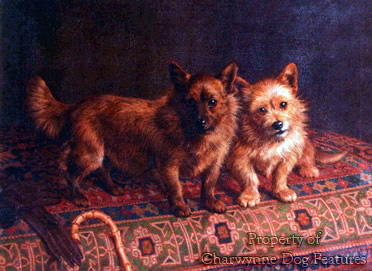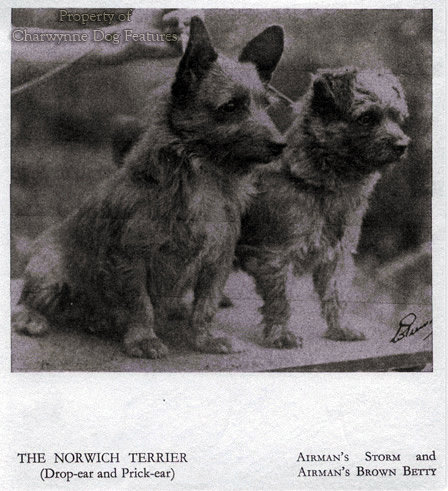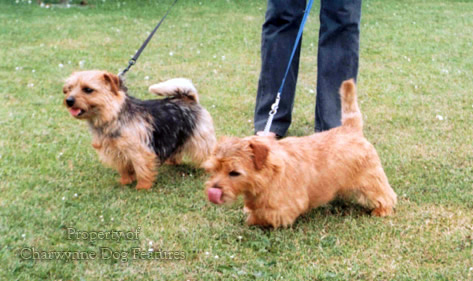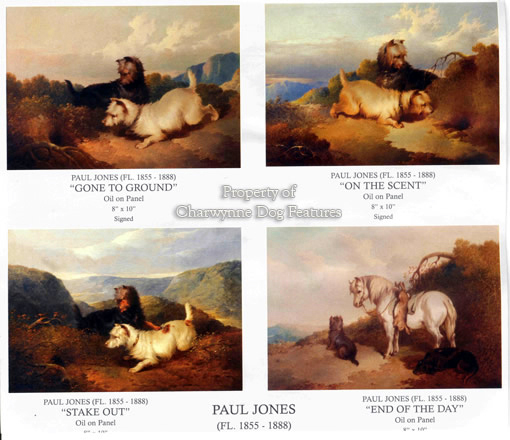759 Earth Dogs From East Anglia
EARTH-DOGS FROM EAST ANGLIA
by David Hancock
 Terriers from East Anglia were largely unrecognised before the advent of showing and the need to establish breed identity was created. Sportsmen there seemed uninterested in claiming local names for sporting dogs bred and developed in those rural areas. We could so easily have had a red retriever, a springing spaniel and a red decoy dog linked with Norfolk by breed title. Small red-tan terriers were once favoured in East Anglia, a Master of the Norwich Staghounds called Cooke establishing a strain of his own. A character called ‘Rough-rider’ Jones who had been in Cooke’s employ, took another hunt position in Leicestershire and took some what were termed Red Norfolk Terriers with him. Frank Jones had arrived from Ireland with a brace of Glen of Imaal Terriers and quickly acquired a Trumpington Terrier. The Trumpington Terrier was an ancestor of the Norfolk and was sometimes called the Cantab Terrier since the undergraduates of Cambridge prized them so much.
Terriers from East Anglia were largely unrecognised before the advent of showing and the need to establish breed identity was created. Sportsmen there seemed uninterested in claiming local names for sporting dogs bred and developed in those rural areas. We could so easily have had a red retriever, a springing spaniel and a red decoy dog linked with Norfolk by breed title. Small red-tan terriers were once favoured in East Anglia, a Master of the Norwich Staghounds called Cooke establishing a strain of his own. A character called ‘Rough-rider’ Jones who had been in Cooke’s employ, took another hunt position in Leicestershire and took some what were termed Red Norfolk Terriers with him. Frank Jones had arrived from Ireland with a brace of Glen of Imaal Terriers and quickly acquired a Trumpington Terrier. The Trumpington Terrier was an ancestor of the Norfolk and was sometimes called the Cantab Terrier since the undergraduates of Cambridge prized them so much.
Jonespurchased every red-coated whelp he could, from a mating between a Dandie Dinmont crossed with a Smooth Fox Terrier and what was described as a cross between an Aberdeen Terrier and a Cantab Terrier. He had a head for business and eventually exported a number of his terriers to America, where they became known as the Jones Terrier. Various American hunts used them, finding them excellent stable dogs as well as fearless earth-dogs. Jones got his foundation stock from a terrier breeder called Hopkins, who actually called his dogs Trumpingtons; he favoured a 14lb dog, red or yellow tan and not ‘too strong-headed’. Like ace terrier-man Jocelyn Lucas he linked the big head with heavy bone, undesired in a working terrier. Many of these dogs had their ears cropped before the practice was made illegal.
Despite their long local history, the Norwich Terrier, then both prick and drop-eared, was not admitted to the Kennel Club’s register until 1932, with the drop-eared Norfolk variety following suit in 1965; some still insisting that this is one breed, embracing both ear-styles, rather than two, as the KC was persuaded.There should be more to a breed than the set of their ears. Both breeds are favoured at a height of 10 inches at the withers, with a hard, wiry, straight coat lying close to the body, in all shades of red, wheaten, black and tan or grizzle, with small white marks or patches tolerated but undesired. With undocked tails, some look spitz-like when the full-grown tail curls over the back. Currently, the drop-eared Norfolk is much more popular, 500 being registered each year against less than 200 Norwich Terriers .
.
In the 1950s, before the separate recognition of the drop-eared dogs as Norfolks, there was much discussion in the dog press about the merits of both styles of ear-set, Mrs EH Hardy writing: “…it is a pity that any comparison should be drawn between the prick and our drop-eared Norwich Terriers, as apart from the set of ears (surely a matter to be left to individual preference) the little dogs have the same characteristics and are equally good at work…There is a pack of tiny working terriers in Eire, (top weight 6lbs), used entirely for work and all have prick ears. They were bred from a Norwich and crossed with hunt terriers…” This exchange of views didn’t cover the enhanced hearing associated with prick-eared dogs, so prized by hunters along the Mediterranean shoreline, from Malta to Sicily and Ibiza and right across to Crete.
The Crufts judge of Norfolks at the 2010 show reported concern over the number of poor heads and weak muzzles found in the entry, not a good sign in a sporting terrier breed. A championship show judge in 2011 reported ‘plenty of steep shoulders and short necks’, serious faults in an earth-dog. There have also been occurrences of ‘fluffs’ in the breed, that is, a soft silky rather luxurious coat, comparable to that of the Soft-coated Wheaten Terrier of Ireland. Fluffs can turn up in the Norwich too, as well as in Welsh Corgis and even German Shepherd Dogs. It may be a freak linked to the tan gene. Coat texture matters a great deal in working terriers, out in all winds and weather. But we do seem to have lost the classic ‘pin-wire’ coat in many breeds intended to be wire-haired. The stiff close coat is so much more a weatherproof jacket, as well as being much easier to manage.
In his Hunt and Working Terriers of 1931, Jocelyn Lucas tells of an Aberdeen sportswoman whose three Norwich Terriers killed over 400 rabbits in four years on their own. Only those rabbits picked up were counted, there must have been many more. In his The Sporting Terrier of 1992, Brian Plummer was moved to record: “To watch a small team of Norwich or Norfolk terriers busily working a rat out of a pile of twigs or a rabbit from a patch of rushes is a delight to anyone who has an eye for a good sporting terrier.” Brian also quotes The Norwich Terrier Club Bulletin of 1955 in which, Molly Richardson, a breed enthusiast, wrote: “I suggest we leave the fox and badger to hunt terriers and concentrate on producing a Norwich Terrier who can and will deal with every other sort of vermin that worries a farmer and one who is also the most active, intelligent and charming companion and assistant to the country man and his family.” It’s against that background that I recommended an outcross to the Norfolk to the Sporting Lucas Terrier Club, with the subsequent progeny becoming known as the ‘Hancock’ line. I shall watch their progress with great interest.